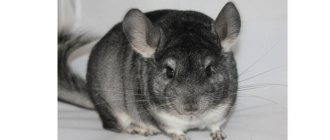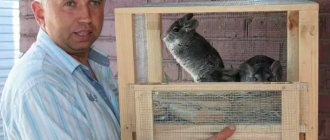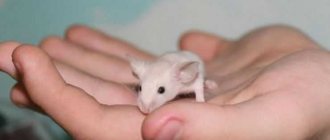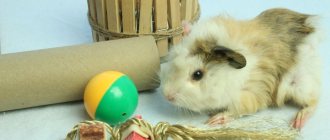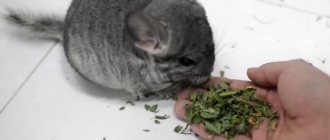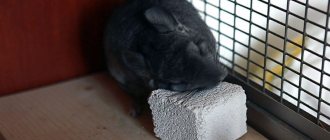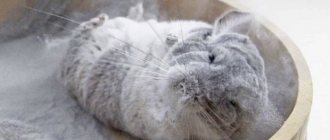- home
- Rat
- Care
08/02/2019 Curious pets, decorative rats love to walk, exploring new territories with curiosity and examining everything around them. A rat harness will ensure a safe walk around the house, yard or along the street. What it should be like, how to make it with your own hands, this article tells.
Why do you need a leash for a chinchilla?
Exclusively for a walk with the animal in the fresh air. But there is a strong opinion that walking chinchillas on the street is not recommended, and there are good reasons for this:
- the animal's fur is so sensitive that it can easily be damaged by a harness and collar;
- furry animals do not walk on their legs, they jump, and therefore accessories for walking can break their spine or ribs;
- in nature in sufficient quantities of various fungi, bacteria and microbes that are dangerous to the life and health of the pet.
There is a lot of new and unfamiliar things on the street, so for a chinchilla this walk can become stressful and cause problems with its heart.
What walks are suitable for a hamster?
There are two types of walks - indoor and outdoor. The former are required in the cold season, and the latter in warm spring, summer and early autumn. Running on the green grass, your pet will experience great joy.
Both types will benefit the hamster. But the owner is obliged to protect the pet from dangerous predators and plants. To avoid losing the animal, use a leash. The product performs a protective function and increases comfort while outdoors.
Important! It is not recommended to trust the care of animals to small children. They are no less curious: they will get distracted and the hamster will no longer be found.
DIY harnesses and leashes for chinchillas
If you still decide to have equipment for hanging out with your pet at home, you don’t have to buy them in the store. A harness for chinchillas should be comfortable and you can make it yourself. To do this, you must have a small piece of fabric, two trident clasps, the same number of regulators, a carabiner and a ring for fixing the leash. Now we take the following steps:
- We take measurements of the neck and chest of the animal, adding 2 cm to the measurements for the seams.
- Draw out an x-shaped part, where the upper part is the neck circumference (with seam allowances), the lower part is the chest circumference (with seam allowances).
- “Tridents” are sewn to the edges, and a ring for attaching a carbine to the upper back.
To keep the leash strong, you need a strong tape. We attach a carabiner to one end, and a loop is made at the other end. The carabiner is attached to the ring. The harness is ready.
It is worth noting that walking chinchillas is extremely undesirable, so a harness and leash purchased in a specialized store, or made by yourself, may turn out to be an absolutely useless attribute.
How to make a vest with a leash
The pattern is cut out and applied to the fabric, and its outline is traced with a pencil or soap. The workpiece is cut and the edges of the fabric are stitched. The next step is to install the fasteners:
- It is necessary to put the future harness on the pet, wrapping it around its body. It is necessary to mark the place where the fastening rings will be sewn on the animal’s belly.
- The ring is sewn to the product from the back side. It will be the attachment point for a carabiner with a leash.
If desired, the product can be decorated with embroidery or fabric stripes. Walking in the cold season requires insulation. A DIY hamster harness is made using two layers of fabric. Between them should be stitched (sintepon, down, etc.). Such an accessory will be not only comfortable, but also warm.
Natural instincts remind the animal of an active life. A hamster in the wild can run up to 10 km in one night. Due to inactivity, the pet gets bored and becomes obese. A leash for walking will be a salvation for the animal, and the person will receive a lot of positive emotions. The article will tell you what types of leashes exist and how to make the product yourself.
Ring-collar for chinchillas (photo)
If a chinchilla family consists of one male and several females, then over time the “wives” will begin to sort things out among themselves. In order to avoid incidents due to “love”, females are wearing detachable rings – collars – around their necks. This is the so-called women's jewelry - a necklace. Such accessories are made of aluminum or plastic. They are not cheap, and they belong to the category of consumables, since the male regularly tries to chew the collar. Therefore, it is necessary to replace the ring with a new one with enviable consistency.
Rings are needed when keeping chinchillas in groups
Collar and its sizes
The collars are available in three sizes:
- 35 mm (No. 1) – for young females;
- 38 mm (No. 2) – standard option;
- 42 mm (No. 3) – for large specimens.
These products made from a fairly durable material - transparent polycarbonate - began to appear on the market. Their prices are more affordable. There are options for making collar rings from fiberglass or getinax. These collars will last longer because they are almost impossible to chew.
Main varieties
It is not recommended to buy a collar for a rat - it is inconvenient and dangerous to use. If the collar is not fastened tightly, the animal will turn out, and if the strap is tightened, there is a high risk of accidentally strangling the pet. Harnesses are much safer because the load is evenly distributed on the animal’s body. Two types of harnesses are common.
From straps
It has a simple design that is conveniently adjustable to fit the size of the rat. The straps wrap around the animal's neck and torso under the paws, and connecting straps run along the belly and back. Such harnesses can be made of various materials - braided cords, leather. Both buckles and latches are used as locks.
Velcro
Usually it has the form of a vest, which is fastened under the animal’s chest. A ring is sewn on the lower part of the back of the product for attaching a leash. These harnesses, made of stretchy nylon, are usually very comfortable and securely hold the animal in place, reducing the chance of it getting its paws free and running away. The fabric of such models is breathable and easy to clean; there are both lightweight and insulated options.
A rat leash can often be purchased complete with a harness. If you purchase it separately, any lightweight material will do. It is also better to choose a mount with a small metal or plastic bracket.
TIP: Modern leashes for rats in the form of a tape measure are very convenient - they provide the animal with more opportunities for free running and exploration, and a thin fishing line cord will save him from the need to drag a rather heavy leash behind him. You just need to watch your pet more closely so that he doesn’t chew the fishing line while walking.
Clothes for furry pets
On store shelves, in addition to toys and other accessories, you can also find clothes for chinchillas. The variety surprises many visitors: jackets, vests, overalls, dresses, shorts and much more. These are excesses and the animals do not need clothing. Moreover, you should not keep your pet clothed in a cage. He will chew on everything he can reach. Dyed fabric can cause chinchilla poisoning. Clothes are bought in order to take interesting photos with your pet, but nothing more.
Chinchillas love freedom very much and will not tolerate any elements of their wardrobe, even the most expensive and beautiful ones, restricting their movements. Do not also forget that the animals have quite warm and dense fur, so additional clothing can lead to heat stroke, especially in hot weather.
Source
What is a harness for?
A rat harness is a special device in the form of a leash, which is attached not to a collar, but to a belt system or vest. The natural instincts of rodents force them, in the event of even the slightest danger, to run away and hide in secluded places. This is why the process of walking a pet becomes a real problem for the owner. To protect yourself from losing your rat during a walk and to control its movement, experts advise using a harness. In addition, such a device serves as fall insurance if the pet is in your arms or on your shoulder.
It should be noted that not all rodents are able to easily respond to the presence of a leash. Many of them will not be able to adapt to the new accessory. Due to the characteristics of the rat’s body, the fragility of the joints, the structure of the shoulders and natural resourcefulness, the pet is able to quickly get rid of any type of harness. However, there are individuals who happily accept the innovation and calmly walk with a leash. As a rule, these are sedentary, reserved and “phlegmatic” male rats who quickly get used to the new device.
Important! You should accustom your rodent to a harness only when the pet is calm and quiet. In case of any manifestations of aggression, it is necessary to immediately release him from the leash.
Useful information about harnesses, leashes and clothing for chinchillas
When purchasing a chinchilla for the first time, many breeders immediately ask themselves the question of acquiring toys, useful devices and other joys for their new furry pets. In the first days of meeting your pet, it is also important to decide whether to buy a leash for a chinchilla. This article will help you make your choice and learn about the main functional properties of this accessory.
Why do you need a leash for a chinchilla?
A leash or harness for a chinchilla may be required solely for the purpose of walking with your pet in the fresh air. At home, the use of such devices is absolutely not justified. However, it is worth keeping in mind that experts do not recommend taking animals outside or advise doing so with the utmost caution.
What is the reason for experts' concerns regarding the owner's desire to walk their furry pet in open spaces? In general, veterinarians do not support the idea of walking a chinchilla on a leash outside for the following reasons:
- The animal's fur is extremely delicate and sensitive, so it can easily be damaged by a harness, collar or other similar device.
- Animals move by jumping, so with any unsuccessful movement, the leash can cause irreparable damage to the spine, ribs or other fragile bones of the animal.
- In an open area, an animal can encounter many harmful bacteria and microorganisms that can cause harm to the health of the individual.
In addition to the above, chinchillas become frightened quite easily, and a new, previously unknown environment can cause them great stress and anxiety, causing heart failure.
Where can you take your hamster for a walk?
The place to walk must be safe. The best option is your own apartment. The hamster can also roll on it in a ball, choosing its own direction. But carrying an animal for a walk in the yard in a walking ball is dangerous, because the door may suddenly open. In this case, the homa will run away and you will never see him again.
It is for street walking that special harnesses for hamsters have been developed. They securely clasp his body: with the correct size, it is almost impossible to jump out of the vest and run away. But during a street walk, you must remember that a tiny animal can suddenly be overtaken by predators. Therefore, we do not recommend dragging your hamster around the yard.
You can walk your animal at your own dacha. It’s great if you have a neatly trimmed lawn: your pet will willingly run on the grass, eat it, and won’t get lost. But you cannot leave a rodent harnessed alone, even in a tied state. Firstly, a neighbor's cat, dog or crows may suddenly appear and offend the defenseless hamster. Secondly, the hamster itself can chew through the leash and run away. Therefore, when walking, make sure that:
- there are no other animals around;
- the harness is not too big for the fluffy one;
- the carbine is in good condition.
These rules will ensure a safe walk and will not allow your nimble pet to escape.
DIY harnesses and leashes for chinchillas
If you still intend to walk your furry pet on a leash from time to time, you don’t have to buy expensive things at the pet store - it’s quite easy to make a leash or harness yourself.
To create an elegant accessory, you will need a piece of fabric you like, 2 trident-shaped fasteners, 2 adjusters, a carabiner and a ring for fixation. The technology for creating a hand-made collar is represented by the following sequential steps:
- take measurements of the animal’s chest and neck and add 2 cm on each side to the resulting figures to process the seams;
- draw an X-shaped pattern, indicating the neck circumference at the top and the chest circumference at the bottom (don’t forget about additional seam allowances);
- sew fasteners along the edges of the pattern, and in the upper part of the back - a ring for the carabiner;
- secure the leash with a special tape that can withstand heavy loads;
- attach a carabiner to the ring, a ribbon to the carabiner, and make a loop at the other end of the ribbon.
Necessary materials
The simplest variety to make yourself is a figure eight shaped harness. In order to make it, you only need one rope. It should be long enough, so it should be used for the area around the neck and body. Therefore, its length should be at least 20cm. Any material will do
However, it is important to avoid rough abrasive ropes, which can irritate the rat's skin.
- A collar that fits the rat's neck.
- One that will hug her chest just behind her front paws.
- A long collar that will be used as a connecting element.
To create a vest harness you will need high-quality elastic fabric and a metal ring. You can use special fabric for animals, but regular fleece or cotton fabric will do just fine.
Ring – collar for chinchillas
If you become the happy owner of not just one chinchilla, but several individuals, then you will soon discover increasing competition between females for the attention of males. To eliminate the consequences of possible unpleasant incidents due to jealousy, experienced breeders recommend acquiring special split rings - collars made of aluminum or durable plastic. Despite the relatively high price, the device will serve you well, allowing you to avoid bloodshed. However, be prepared for the fact that such “decorations” will have to be changed often, because the males constantly strive to gnaw them. A standard collar looks like this:
Collar and its sizes
Manufacturers produce ring collars in three sizes:
- No. 1 (diameter – 35 mm) – for young animals;
- No. 2 (diameter – 38 mm) – standard size for an adult;
- No. 3 (diameter – 42 mm) – size for large individuals.
The process of creating a harness
The process of creating a traditional rat harness involves a few simple steps:
- First of all, the pet is measured according to the above parameters.
- Make two sections taking into account the length of the locks or additional length in case of using Velcro. The resulting closed parts must match measurements “a” and “b” in the pattern presented above.
- The finished elements are connected with strips, the length of which is equal to measurement “c”.
- A steel ring or loop required to secure the leash is attached to the element located under the pet’s limbs.
- The locks are sewn into the rodent's belly or back.
Important! Do not put a collar on a rat. If it is not tightened tightly, the pet can easily slip out, and if it is tightened too tightly, there is a high probability that the rodent may suffocate.
Clothes for furry pets
In addition to many accessories and toys, owners often want to purchase clothes for chinchillas. Modern pet stores amaze with the variety of wardrobe models for animals. What you won’t find here: coats, overalls, jackets, dresses, shorts and much more! You can easily lose your head with so many products.
Be vigilant and never forget that physiologically your pet simply does not need clothes! In addition, having dressed in an attire that the owner likes, the chinchilla will probably want to chew it, and this can already result in poisoning with dyes and other substances with which things are impregnated. If you really want to dress up your pet, do it for a short period of time (for example, during a photo shoot).
Results
A rat on a leash looks interesting and elegant. You need to accustom her to such walks first indoors, then in deserted places outdoors. Until you are completely sure that the rat feels good in a harness, you should not go for a walk with it in the park. Even in this case, you need to be careful so that other animals do not attack your pet, or that it does not fall under the wheels of a bicycle or car. It is necessary to ensure that all locks on the harness are securely fastened.
Types of toys and additional accessories for chinchillas
Chinchillas are active, positive and very funny animals. Many breeders, in order to diversify their pet’s days, buy and install special toys in their cages. In addition to toys, furry pets require accessories such as a carrier and a fur brush. Some owners also buy harnesses and leashes, but there are many dangers associated with their use.
Can chinchillas live outside?
Can chinchillas live outside?
Pet chinchillas must be kept indoors as they cannot withstand low or high temperatures. When exposed to low or high temperatures, your chinchilla may develop health problems. Although chinchillas have thick coats, they should not be kept outside. Chinchillas do not have sweat glands like humans, so in warmer temperatures they cannot cool down as quickly.
Types of toys for chinchillas
Toys for furry rodents are made from different materials, but they all have one common requirement - safety. Therefore, you should not buy and use toys from:
- Plastics,
- Rubbers,
- Plexiglas,
- Cardboard, foam or paper,
- Any material with a high content of gels, paints or varnishes,
- Any material containing cement or lime.
Most often, toys for animals are made from ceramics, wood, stone, metal and plant fibers.
Wooden toys must not contain any traces of paint and be made from approved types of wood:
Wooden toys can be either static - attached to the floor or walls, or free-lying. All kinds of swings and ladders, houses, shelves, labyrinths and ladders are most often made from wood.
When choosing a ceramic toy, you should carefully inspect it for the absence of sharp corners or protrusions. You can use flower pots, drainage pipes of suitable diameter and other pottery items.
Stone toys are designed to grind down constantly growing teeth, which means they should not contain dangerous inclusions. Most often, stone toys are stones for grinding teeth. Sometimes they are shaped like a castle, a fruit or a vegetable.
All kinds of ropes, hammocks and ladders, ropes, bedding, baskets and bowls are made from plant fibers. The main condition is that the fabric must not be bleached or dyed.
Metal toys are represented by various running wheels.
Can chinchillas live outside in a barn?
You should never keep chinchillas outside in a barn.
Chinchillas require a controlled environment. The only way to keep your pets in the barn is to renovate the barn. This is an expensive installation as the canopy will require double insulation and dehumidifiers to be installed.
Most barns can be cold and windy. Such conditions can have adverse effects on chinchillas.
The ideal temperature should be between 18°C and 21°C and no higher. The air inside the shed should also be free of moisture, which is difficult to do in such an environment. The moisture causes their fur to grow fungus.
Always keep your chinchillas inside and their health will thrive. Chinchillas are suited to being kept indoors and this will allow you to keep them in a controlled temperature environment.
DIY pet toy
Toys can be not only purchased. Chinchillas are quite smart animals and adapt a variety of objects for their games. Even a nut shell can become a furry pet's favorite toy. Some breeders prefer to make toys for chinchillas with their own hands. For the most popular option you will need:
- Metal chain from a hardware store,
- Several metal key rings,
- Branches of any permitted tree,
- Drill,
- Saw.
The twigs must be washed well and dried, preferably in the oven. The branches are sawn into bars and rounds. A hole is drilled in each of them, with a diameter equal to the diameter of the chain. A chain is threaded through all the branches, and key rings are attached to its ends. They are very convenient for hanging a ready-made toy on the walls of the cage. The number of branches and the length of the chain depends only on the wishes of the breeder and the size of the cage!
Stuffed Toys
But the use of soft toys is a very controversial issue. Some breeders claim that their pets play with plush toys and even sleep cuddled with them. However, most have a negative experience: the toy quickly breaks into pieces, the filler and other parts end up in the pet’s stomach and cause poisoning of varying severity, intestinal obstruction and even death. If you wish, you can try giving a soft toy to your pet and see his reaction. It is likely that the animal will make friends with the toy. However, this does not mean that after some time the chinchilla’s plush friend will not be torn to pieces.
At what temperature can chinchillas live?
Chinchillas do not tolerate high temperatures or humidity well because they come from mountainous regions with a cold and dry climate.
Chinchillas prefer cooler temperatures because they can usually be more active without overheating.
Chinchillas' natural habitat is a cool and dry region with a constant temperature of 10 to 12 °C.
Temperatures above 26°C will stress chinchillas. The suitable temperature for keeping a chinchilla should be between 16°C and 21°C and the humidity level between 40% and 60%.
Chinchillas cannot cool down quickly because they do not sweat (they do not have sweat glands); hence, they are susceptible to heat stroke. Before hot weather hits, make sure you can cool the room to a moderate temperature if it gets too hot.
Place the cage away from direct sunlight, which can cause overheating. There are many ways to keep your chinchilla cool, the most effective of which is to use air conditioning.
Chinchilla carrier
When choosing a carrier, you should focus on what it will be used for. If for a short trip - to the doctor or to the country, then it is better to choose a small box that can be easily placed in a bag and insulated if necessary. It is better not to buy a carrier that is too large - the animal can easily be injured. However, the box should not be too cramped - cramped space will lead to stuffiness. There is no need to try to find one carrier for two or more animals: transportation is always carried out in individual boxes.
Nursery of decorative rats, Moscow
You can find rat harnesses . Is it necessary?
I can immediately say that buying a rat harness is money thrown away. The first and main reason for this is the unique structure of the rat’s skeleton, thanks to which it can twist out of any position. Plus, a rat can simply chew it through.
In addition, it is almost impossible to put a harness on a rat correctly. If you tighten it a little more, the rat may simply refuse to walk and fall over on its side. And if you weaken it a little, the rat will run away before you even have time to blink an eye.
There are
rats that move perfectly on a harness . But usually these are calm individuals who, even without it, will not leave their owner even a single step. A harness can be useful in two cases:
- It can be put on a rat that sits on your shoulder while walking. The harness will not interfere with her in such a situation, but will help catch the rat in case of a fall.
- For beauty. A rat on a harness will look very impressive in photographs, at performances and competitions... The rat will last three minutes, and you will have time to appear in all your glory.
Clothing, leashes and harnesses for chinchillas
The accessories for chinchillas presented in stores today are so diverse that they confuse breeders. The most controversial product is the leash with harness. It is strictly forbidden to walk chinchillas on the street. And there are several reasons for this:
- Chinchilla fur is easily damaged by any harness or collar,
- Chinchillas don't walk - they move by jumping. A collar can break your spine, a harness can break your ribs,
- There are quite a lot of dangerous bacteria, microbes, fungi,
- A sudden change of environment, new smells and sounds, bright light - all this will lead to very strong stress and can provoke a heart attack.
- A chinchilla is usually walked at home, but for home walks a harness and leash are not needed.
- In the same way, leashes and harnesses are not needed for exhibitions - the animal is placed from the carrier into the exhibition box.
Products for chinchillas include a variety of clothes: vests, jackets, shorts, overalls and dresses. There is no need to talk about the actual use of such accessories: you cannot leave an animal in clothes in a cage - in a few minutes the pet will chew everything it can reach and also get poisoned by the dyed fabric. At exhibitions, animals also do not need additional decorations. The downside is that the chinchilla is a freedom-loving animal, and it can be very difficult to persuade the animal to wear clothing that restricts movement.
It is also worth remembering that the animal’s fur is quite dense and warm, which means you can get heat stroke from wearing clothes, especially in the summer months.
How to properly put a leash on a hamster
To put a standard harness on a hamster, you need to:
- take the leash in your hand so as to simultaneously hold both rings in the same plane;
- put the larger ring under the belly, the smaller one under the neck;
- on the larger ring it is possible to adjust its width so as to conveniently fix it on the hamster;
- check the fasteners and tighten them if necessary.
How to put a leash on a hamster: video
To put on a sewn leash vest you need:
- attach the vest to the back;
- fasten both fastenings - on the stomach and on the neck;
- insert the leash into the fastening ring.
You can choose any form of pet walking. But you can’t leave him motionless in a cage, because this negatively affects his health and provokes obesity and other pathologies.
You also don’t have to walk your hamster outside to avoid contact with infections, worms and skin parasites, but anyone can create conditions for him to walk around the house.
Was this article helpful? Yes No Has already helped 38 times
Hamsters Rodents and rabbits Accessories for hamsters DIY for hamsters
Fur care
But what is really needed is a good brush to care for the animal’s thick fur. They get used to using a comb gradually. Usually chinchillas like this procedure and do not express dissatisfaction. Regular brushing will help avoid many problems with skin and fur: dermatitis, fungal diseases, infection with skin parasites. Also, using a comb before the exhibition, you can give your pet a more neat appearance.
However, finding a special comb for a chinchilla in Russia is not so easy: the product is quite rare and expensive.
It differs from ordinary brushes for animals by thinner, sharper and more frequent teeth, which can be compared to needles from a sewing machine. This brush combs out the animal’s thick fur well. You have a better chance of purchasing a special comb if you go to a large nursery. Typically, large breeders bring specialized products from European farms or work directly with manufacturers of products specifically for chinchillas. If this is not possible or the price of the product is too high, you can choose a brush for a cat or dog with the longest and most frequent teeth.
Source
Can a chinchilla live outside?
Pet chinchillas cannot withstand terribly cold or hot temperatures. Chinchillas often develop respiratory infections that can progress to pneumonia and even death due to prolonged exposure to temperatures below 10°C.
During the colder months, if you lack warmth, you can purchase a safe heat source for your chinchillas. You can place a standard lamp (such as one with an aluminum bowl surrounding the bulb) directly above the pet's cage. Make sure that the lamp cord does not touch the top or sides of the cage, as chinchillas will chew on anything soft.
You don't want to shock your chinchilla. Choose a bulb that will heat the area to around 13-18°C.
Always keep a thermometer handy to check the temperature. The lamp power depends on the distance to the chinchillas, as well as the room temperature. Placing towels around the cage can help prevent heat loss. However, always be careful how you stack towels to avoid fire hazards. It would be best if you are wary of your chinchillas as they may also start chewing the towels.
It is important to ensure that living conditions do not become too hot. It is best to keep your chinchilla indoors where you can control the temperature.

